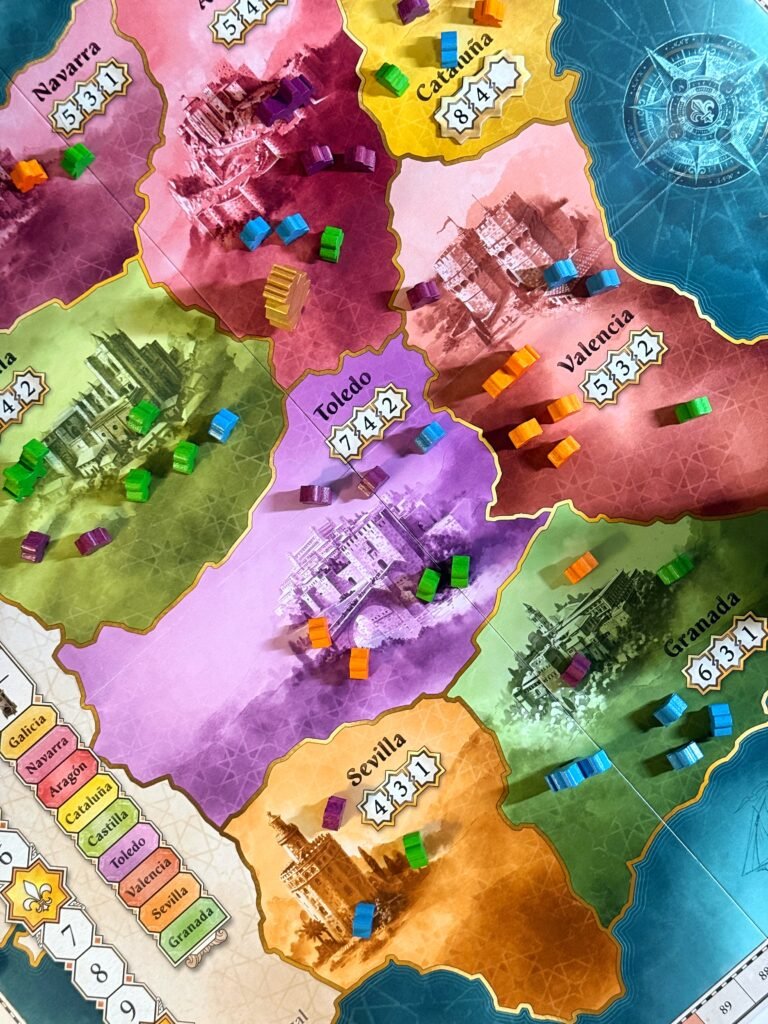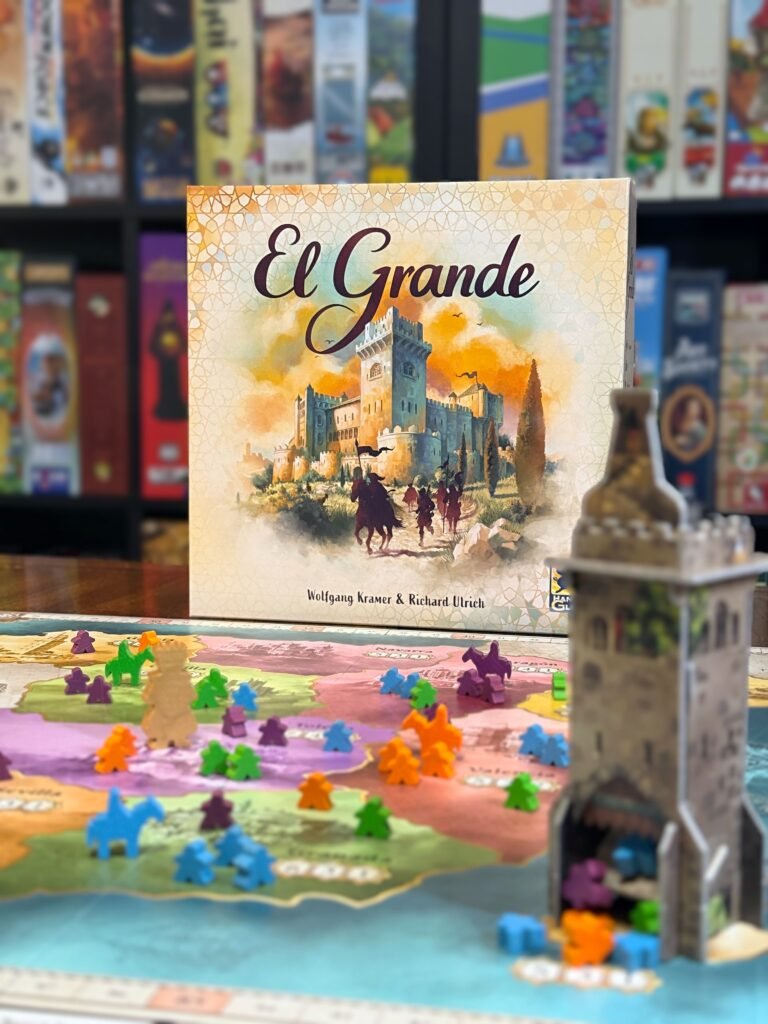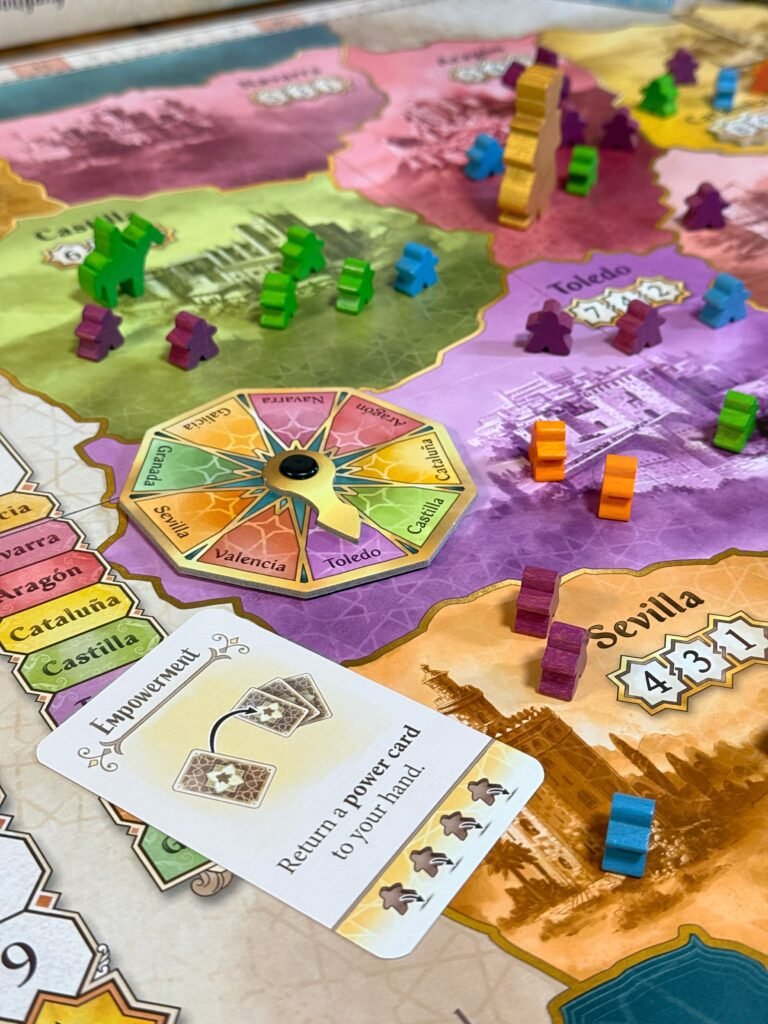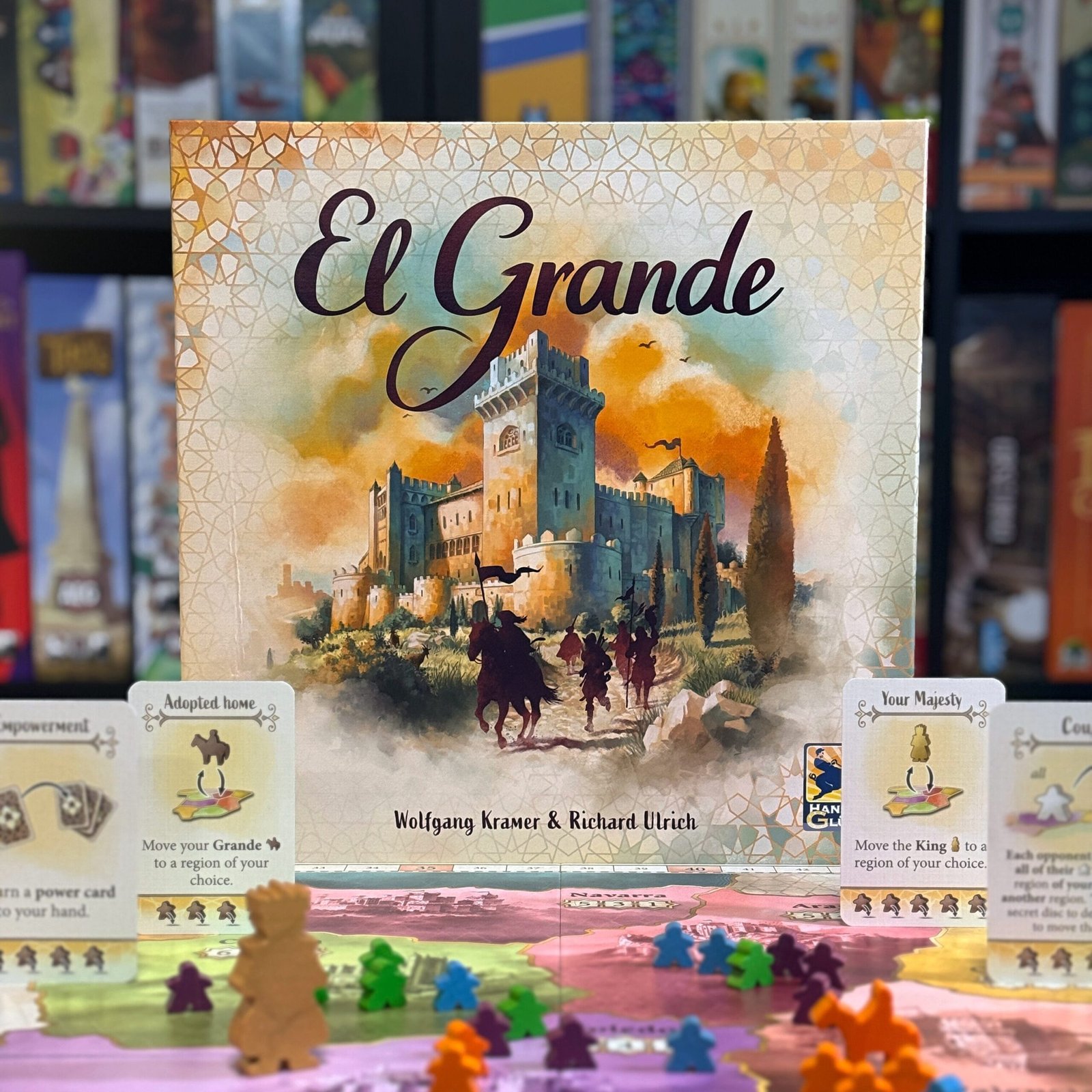A Game For The Friends We Don’t Have
Have you ever played a game and instantly known it’s going to be good… but only if you had more friends?
We just played El Grande, a Euro classic so old it predates Corinna. Heralded as one of the greatest games of all time, and a foundational pillar of the area control genre. It’s been studied, exalted, and enshrined in BGG top lists.
And we? We played it at two.
How It Plays
El Grande takes place on a map of Spain, divided into nine regions. During each of the game’s three scoring phases, players vie for majority control to earn points.
Simple enough.
Each player controls a Court, where their available Caballeros (aka meeples) await orders. A shared Province holds the rest in reserve.
Each round, you’ll play one of your numbered Power Cards (1–13). The lower the number, the more meeples you’ll gain — but the worse your turn order. Then, in that turn order, players pick from five Action Cards: four are randomized, and one always lets you move the King. The meeples from your Power Card go to your Court, while the Action Card decides how many you’ll actually place on the map.

What makes it sing is how tightly those Power Cards are controlled — you only have one of each, and no one can repeat a number within the same round. Locking in your turn order becomes crucial if you want to guarantee you’ll get to play the card you’re eyeing. With each round, the tension cranks higher. You only make this choice nine times, but every single one feels agonizing.

The King restricts where you can place meeples, the board shifts constantly, and you’re always weighing whether it’s better to grab the action you want or secure the meeples you need.
Then there’s the tower. No, the Castillo. A cardboard pillar where players secretly drop meeples instead of placing them openly. At each scoring phase, the Castillo is resolved as its own region before everyone secretly redeploys those freed meeples. Bluffing, guessing, second-guessing—it’s brilliant.
Unless you remember exactly what everyone dropped in there.
Which, at two players, you do. Easily.
Area Control With No One to Control
Look, we read the box, okay?
A bit of research might have warned us off. “Best with four or five,” the forums whispered. “Avoid two,” others mumbled, in the hushed tones of those burned by a variant involving a fake third player and half the board being covered like an embarrassing rash.
But the box said 2–5. So we did what any optimistic duo does: we bought the game.
We shouldn’t have trusted the player count. That trust was shattered almost immediately.
Because El Grande thrives on two things: bidding and area majority. Both are glorious when there’s a full table of grinning, scheming people. At two? It’s poker with your cards face-up.
It’s not that it doesn’t work; it’s just hollow. Too open. Too trackable. Too polite.
The Problem Isn’t Us. It’s Us.
So mid-game, we found ourselves spiralling into bigger questions:
Should publishers be more honest about how many players their games are really for?
We get it. Selling games is hard. Two-player compatibility is a massive market; 60% of gaming groups are couples or pairs. You want to appeal to that.
So you write “2–5 players” on the box. And technically, maybe there’s a variant. Maybe you invent a ghost noble named Greg to fill the third chair. Greg ruins your plans better than your actual partner could.
But what are we doing here?

Too many of us have sat down with a beautifully crafted Euro, peeled open a gorgeous board, and then spent fifteen minutes covering half of it up like we’re ashamed of its grandeur. Too many games ask us to simulate extra players, remove key components, or fundamentally change the game just to make it “work” at two. That’s not adaptation. That’s cosmetic surgery.
And yet… we keep buying them. Because we don’t read the recommendations, we read the BIG bold “2–5.”
The Consumer Demands Lies!
We want it all. Tight and tactical at two. Chaotic and wild at five. Under an hour. Solo mode included. Bonus points if it teaches the dog to fetch.
Publishers are stuck. Label your game 3–5, and you lose sales. Make a two-player variant, and you risk giving people an El Grande experience that feels more like El Meh.
Who’s at fault? Us? Probably. But also… just put the recommended count on the box, yeah? Something like:
“Best at 4–5. Playable at 2, but prepare to roleplay an invisible third player named Greg.”
Let us make better decisions.
But then we’re full circling, probably now complaining that the game should be more flexible. It’s the eternal whine of the modern board gamer: we want honesty, but also perfection.

Are We Still Talking About El Grande?
Yes. El Grande is good. Really good. We can feel it. The bones are solid, and the design is brilliant. Every decision we made wanted to sing. But at two? It felt like listening to a symphony performed on two slightly out-of-tune violins.
We ran the two-player variant. It technically worked. We had tension. We had fun. But it was like watching a war movie where only two people show up on the battlefield. The drama was there. The spectacle wasn’t.
The Castillo? Clever. But at two, it loses its magic. You know what went in. Bluffing collapses under scrutiny.
With more players, El Grande becomes a social knife fight. The leader gets dogpiled. Alliances shift. Everyone’s whispering across the table, “No, no, don’t stop me—stop them.” It’s delicious.
You Can’t Plan, and That’s the Point
What really makes El Grande tick is how tactical it is. Long-term planning? Forget it. The board shifts constantly. Action cards throw wild punches round after round. It’s like pushing a shopping cart across cobblestones: you know where you want to go, but you’re going to veer, swerve, and crash into your own bad decisions along the way.
There are clever, sneaky ways to score. Second place in six regions still wins points. Off-turn actions can tilt the map. It rewards the attentive, the reactive. But the chaos might frustrate players who like clean, planned paths to victory.

If you know someone who hates getting blindsided? Maybe leave this one in the box.
It’s Not You, El Grande. It’s Us.
We owe El Grande an apology. We don’t hate it. In fact, we’re pretty sure it’s brilliant. Just… not here. Not now. Not with us.
It’s a classic for a reason, and this reprint makes it even better. The board is prettier (you don’t want to see the other guy), the King is golden and crowned, the organization is pristine, and everything’s eco-friendly. Meeples replace cubes. The new Grande piece actually looks like someone on horseback, not just a big cube’s awkward cousin.
It’s smart. It’s balanced. Even on your first play, you feel like you can win. No steep learning curve. Just clever plays, reading the room, and picking your moment.
El Grande is amazing. If you regularly have four or five players? It’s a must-own. A masterpiece.
It’ll live on our shelf a while longer, waiting for the right evening, the right group, the right spark. Until then, it’ll sit like a nobleman without a court—respected, storied, and a little bit lonely.
And maybe that’s okay.
Just label your boxes better, yeah?
Corinna’s Rating: 7.6
Duncan’s Rating: 7.2
Check out El Grande on Board Game Geek for more information.
A copy of this game was generously provided by Asmodee for content creation.


Leave a Reply